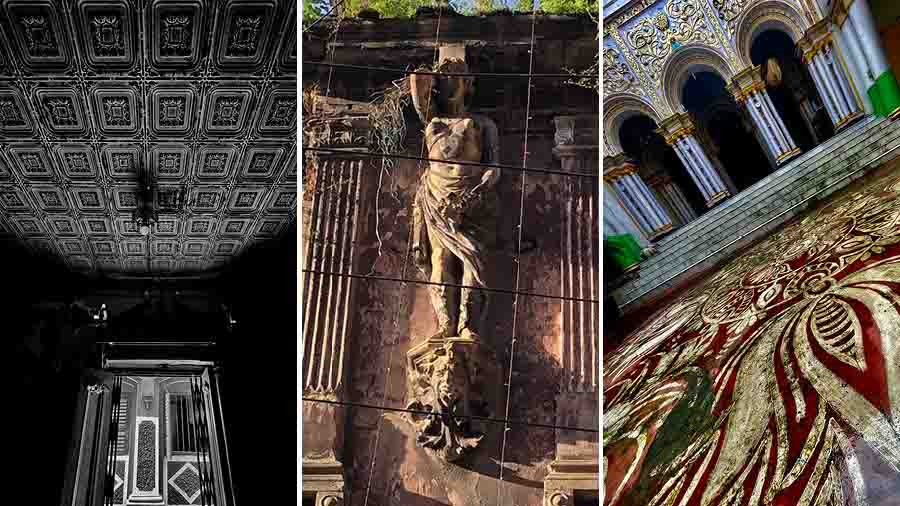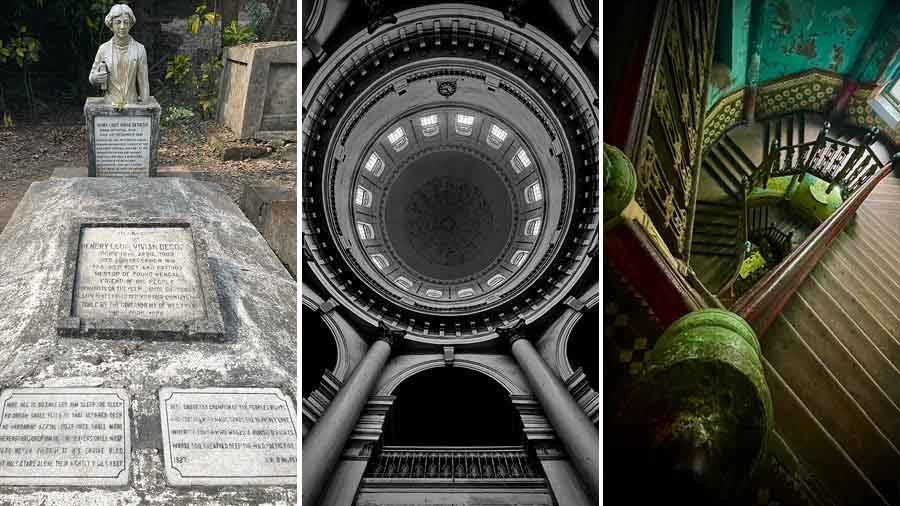Continued from here.
Ram Gopal Saha bari

There are larger thakurdalans in Calcutta, but if I have to press the case for this Thakur Das Palit Lane property – especially during Durga Puja, when its raunaq is enhanced by visiting family members in their traditional silks – is because this one bigha spread is the largest in the neighbourhood, has been virtually untransformed across the centuries (1.75 at least), is remarkably maintained and has a gold-bevelled thakurdalan façade (‘embroidered’). The bonus is the red oxide zameen of the courtyard with the arrestingly outsized alpona. I have seen photographers do re-takes of the thakurdalan cum alpona, shoot from scattered vantage points, transform them into reels and post them on social media. The untold story of the property is that of the family – an impoverished boy from Burdwan who made it big in the city as a wine merchant to be able to build this place, father 17 children, start a Durga Puja in gratitude with a 50 paise budget – and then leave it all by the age of 47 to pass into the ages.
The small tragedy is that the thakurdalan gets so much attention that the linearly disciplined ‘rawk’ – from which the family must have engaged with the world, dissecting Canning, Vidyasagar, Tagore, Curzon and others – on the outside gets overlooked. Best of all, the inheritors are as large-hearted as their property, and have generally been welcoming of unannounced walk-in vagrants like me.
Arched house of Nilmoni Mitra Street

If you should go to The Bhawanipur House for a meal and engage in the zehmat of climbing the stairs to the restaurant rooms on the upper floors, you will pass a framed watercolour of an arched geriatric structure – but these arches are different. There is a sequence running on all four sides of the quadrangle. There is a touch of the oriental. There is a combination of colours (brick red and yellow). If TBH drew this Calcutta vignette from hundreds, there is a reason. When you pass the pebbled rawk of this property in Nilmoni Mitra Street (speck in the vast heritage ocean that is also referred to as ‘north Kolkata’) to enter the premises, your first response will be of silence. You will not want to extend beyond a whisper lest one of the residents widens the window to ask ‘Kayyyyy?’ You will be flitting orgasmically between ‘1.0’ and ‘0.5’ on your phone to get unusual perspectives that you believe no homo sapiens has attempted. You will spend minutes wondering the kind of money people made in the last-to-last century to make homes like these (an ancestor sold textiles to the British during the Boer War, if you need to know). It is the kind of courtyard I would take artists to, all canvases paid with a two-word agenda: ‘Do crazy.’
Temple on Ramdulal Sarkar Street
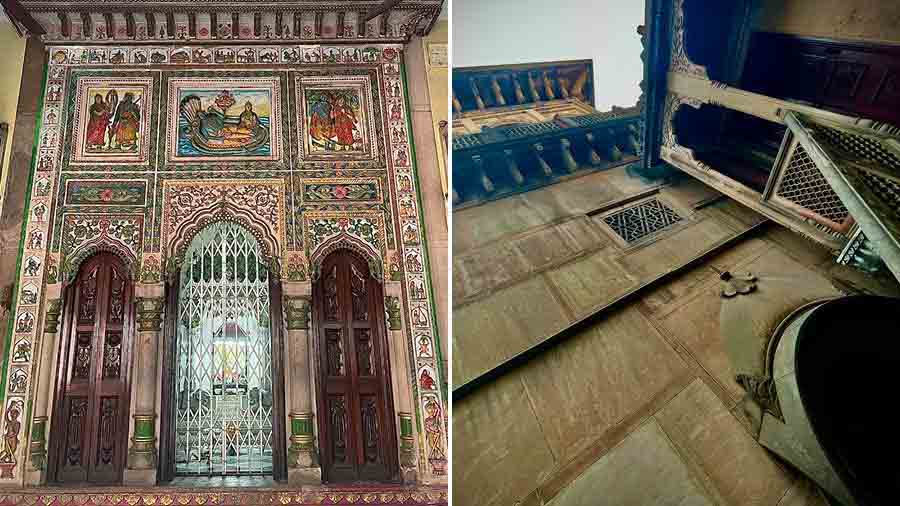
If you drive from south Calcutta past College Street, pass the Great Swami’s home on the left, take the first motorable lane on the left, pass Nakur Chandra Dey of sandesh core competence and reach the first lane on the left, stop. You are standing at a dramatic point. Behind you is the lane on which lived KC Dey, family and nephews (one of whom sang for 61 years in Hindi cinema).
In front is a red-storeyed building where the greatest poet of his time (Ghalib) stayed for days while petitioning the angrez hukoomat for an allowance (the right word is ‘vazeefa’). Beside that structure is a mandir – in stylistic contrast. There is ‘Rajasthan’ written all over. I am not a master in stones but my un-informed eye says it is possibly Dhaulpur. I have been to this mandir in the morning hours, only to find the collapsible gate padlocked and a voice from behind the premises send me off with the words: ‘Baad me aiyyega. Abhi bahut kaam hai!’ She thinks I might be interested in worshipping inside. I am disappointed with the interiors (anyone would after seeing the exterior). I often get visions of engaging a light designer to illuminate the façade. Could emerge as a traffic-stopper until KP sends me a message: ‘Puro rasta jam koray diyechen. Light-ta off korun!’
Mandir across Adhikari Bhaban
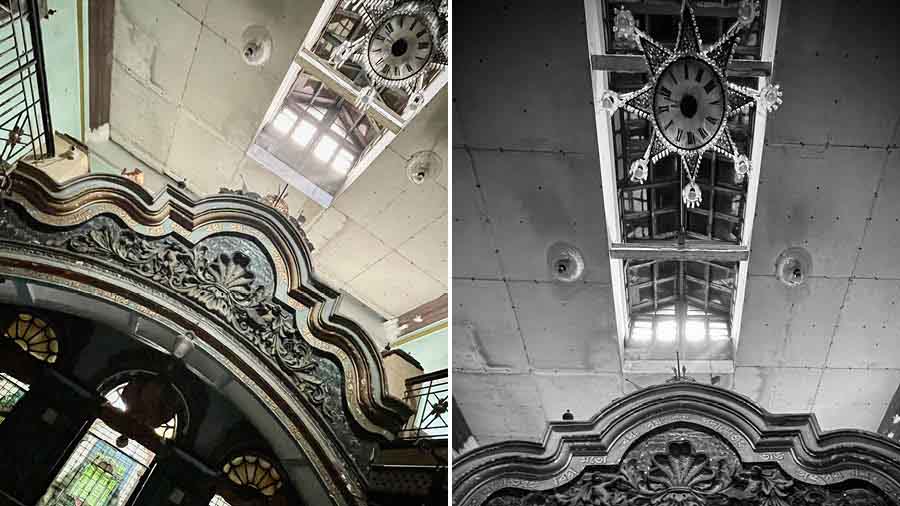
On Shashi Bhushan Dey Street in Bowbazar, stands a red mansion with a distinctive façade feature – one part of the mansion is connected to the other across the bylane, but at a comfortable height to permit two vertically-stacked double decker buses to pass below. And here lies the irony. Most people take pictures of the façade connector from this side, under-side and that side and while their attention is monopolised by this distraction, they miss the more remarkable dimension of this twin-property – the mandir. We sought permission last Saturday (‘the genuine ‘Onek dur theke eshechi aamra’ tugged the right heartstrings) and entered. The windows were largely closed. We insisted that all artificial lighting be turned down. Then wordlessly stood in the semi-darkness.
The pictures indicate that we got a carved ceiling (can’t have been wallpaper); the celestial serpent above the deity enclosure came off effectively; the clock embedded into the chandelier was unique; the mechanical gong in the ante-chamber kept me engrossed (‘Come, come, you must see this!’). In such homes and homage havens, it is still 1923 and any muhurt, the korta could step inside for his morning obeisance.
‘The facade’ on Pathuriaghat Street
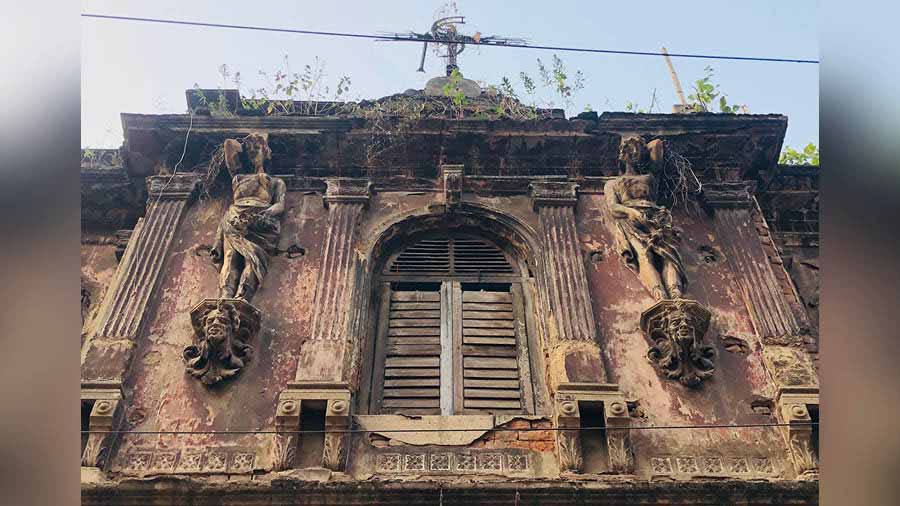
There is a façade on Pathuriaghat Street that we all refer to as ‘the façade’ without knowing the name of the building. The trick lies in taking visitors to this street and just when they have reached the specific point, ask them to stop turn left / right (depending on the direction you are coming from), raise their sight…and then hear the straw drop for the next minute before the hand involuntarily turns to the smartphone camera. To call this a ‘façade’ would be like calling the marbled David in Florence a statue. This is an experience instead.
These are some of the things that will strike you: the faded brown-crimson of wall paint; the inscrutable identity of the façade ‘personalities’ (I started referring to them as ‘Apollo’ and ‘Venus’ following intellectual fatigue); the size of the personalities; the criss-crossing wires that have keep Adobe Photoshop in business; the manual clothes washer / bather making a complete use of the ganga-paani at the entrance wondering why we would be wasting our time taking pictures of the ‘angrez wali madam’.
